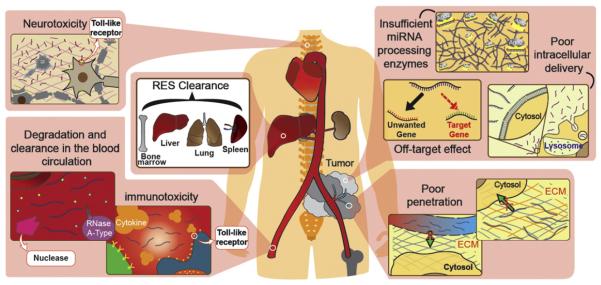Fig. 2.
Barriers of In vivo miRNA delivery for cancer therapy. The leaky structure and compression of abnormal tumor vessels lead to poor blood perfusion, which reduces the delivery efficacy of naked miRNAs. Extravascular miRNAs encounter the ECM, which blocks the penetration of miRNAs into tumors. Intravascular barriers including enzyme degradation disrupt the unmodified naked miRNAs. Also, miRNAs carried by nanoparticles larger than 100 nm in diameter increase the RES clearance in the liver, spleen, lung and bone marrow, which results in non-specific uptake by innate immune cells such as monocytes and macrophages. Moreover, miRNAs can cause immunotoxicity by triggering secretion of inflammatory cytokines through Toll-like receptors. Neurotoxicity may also be induced via miRNA-bound TLRs. Once miRNAs reach the target tumor cells, the intracellular miRNAs may be trapped in the endosomes and degraded in lysosomes. Off-target effects of miRNA may cause unwanted side effects and insufficient or saturated miRNA processing enzymes may result in deficiency of miRNAs.

